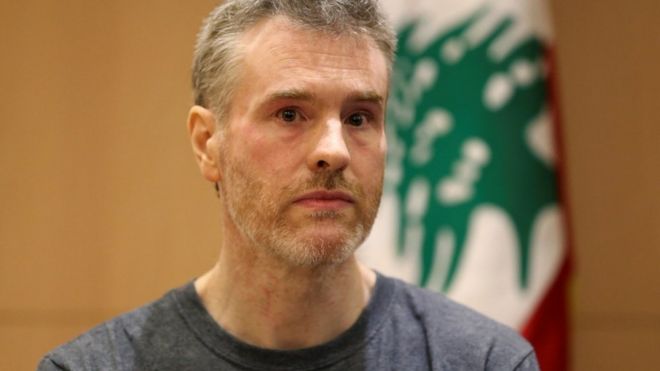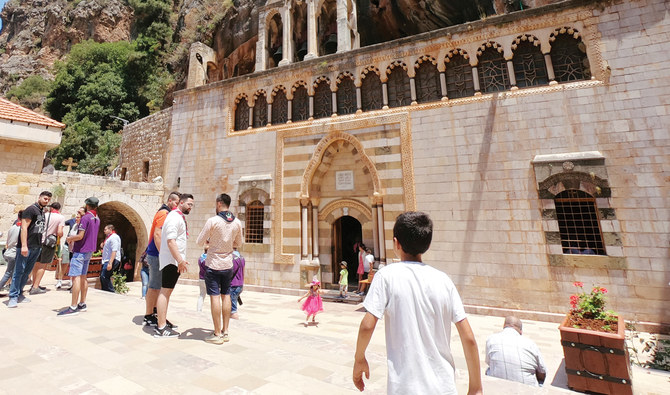Reuters — BEIRUT — Saudi Arabia and the United Arab Emirates are looking to invest in infrastructure projects in Lebanon after ties have recovered, Lebanese Prime Minister Saad al-Hariri said in comments from his office on Friday. Hariri, on a visit to Washington, also said there were negotiations “over financial and economic aid” with the […]
WASHINGTON (Reuters) – Lebanese Prime Minister Saad al-Hariri said on Thursday after talks in Washington that he hoped for a final decision, possibly in September, on a proposal for resolving a maritime border dispute with Israel on a gas pipeline. U.S. Secretary of State Mike Pompeo welcomed Lebanon’s commitment to the talks and reiterated Washington’s […]

by dailystar.com.lb — BEIRUT: When Hamza Shamas first moved to Beirut, he was overwhelmed. The constant bustle of the city’s busy Downtown was a far cry from the quiet village of Boudai, where he grew up. In his village, Shamas’ identity revolved around his tribe, but in Beirut he felt adrift.He settled in Hay al-Sellom, a low-income neighborhood in the southern suburbs made up almost entirely of residents from rural Lebanon, and soon discovered that despite the noise and crowding, his community in Beirut was really a microcosm of village life. More and more people originally from Lebanon’s rural population are finding themselves in cities. The United Nations Human Settlements Program (U.N.-Habitat) estimates that by 2020, 88.6 percent of Lebanon’s population will live in urban areas, the fourth-highest in the Arab world after Gulf states Kuwait, Qatar and Bahrain.
The vast majority of this urban shift is focused on Beirut. A 1996 survey by the Social Affairs Ministry and the United Nations Population Fund, UNFPA, found that 20 percent of Lebanese living in the Beirut governorate were born elsewhere, along with 31 percent in the Mount Lebanon governorate, which encompasses Beirut’s dense suburbs. This greatly exceeds the proportion in other governorates, at 8 percent in the north and 2 percent in the south. In the intervening two decades, the proportion of Lebanese migrants to the Beirut area has only increased, said Suzanne Menhem, a sociology professor at the Lebanese University. She is in the midst of a yearlong study of Lebanon’s internal migration, a woefully understudied phenomenon, she told The Daily Star. “We have no statistics,” she said. “We base it on the study and by estimation.” Lebanon’s last official census was in 1932. Since then there have only been scattered studies of the country’s demography. Menhem is still in the initial stages of her project, but she already knows that the trend of rural-to-urban migration is a strong one. “I’m sure that this phenomenon is increasing with time,” she said.
by businessinsider.com —Saudi Aramco on Monday said it agreed to acquire a 20% stake in Reliance Industries’ refining and petrochemicals business, valued at $75 billion. The $15 billion deal between the world’s largest oil producer and Mukesh Ambani, Asia’s richest man as well as Reliance’s chairman and largest shareholder, gives it a stake in the […]
by naharnet — Maronite Patriarch Beshara al-Rahi on Sunday said Lebanese politicians are “experts in creating and resolving obstacles,” referring to the latest deadlock over the deadly Qabrshmoun incident. “Lebanese politicians have proved anew that they are experts in creating obstacles and paralysis and in resolving the obstacles and resuming activity, after they subject the […]
BEIRUT (Reuters) – Lebanon’s cabinet met on Saturday for the first time since late June, a day after steps were taken to resolve a political dispute that had paralysed a government seeking to reduce massive public debt. Information Minister Jamil al-Jarrah, speaking on television after the meeting, said an investigation into a shooting incident which […]

BySARAH EL DEEB, ASSOCIATED PRESS — Details of Baxter’s detention were not immediately available but Canadian media reported last December he was detained while in war-torn Syria, where he was traveling seeking an adventure. Canadian officials declined to provide further information, citing privacy provisions. Lebanon’s General Security Chief Abbas Ibrahim said Baxter was detained for what Syrian authorities considered a “major violation” of local laws, adding that authorities there may have considered the incident security related. He didn’t elaborate. Baxter appeared briefly on a podium, shared with Ibrahim and the Canadian ambassador to Lebanon, Emmanuelle Lamoureux. He was emotional and choked on his words as he tried to hold back tears. “I’d just like to thank the Canadian embassy for helping me,” Baxter said, reaching to hold the shoulder of the Canadian ambassador. “I would like to thank the Lebanese for helping me get free. I thought I would be there forever, honestly.” He added, wiping his eyes: “I didn’t know if anyone knew if I was alive.”
Baxter’s release marked the second time Lebanon has helped free a foreigner held in Syria. Last month, Ibrahim also mediated the release of an American traveler, Sam Goodwin, held in Syria for two months. The circumstances of Goodwin’s detention in northeastern Syria in May were unclear. “I think the work and effort we did shortened the period of (Baxter’s) detention and as you see he is on his way to Canada,” Ibrahim said Friday before Baxter spoke.
by AP — BEIRUT — Lebanon’s only English-language daily protested the country’s deteriorating economic and political conditions by publishing a blank edition Thursday, calling it an “alarm bell.” Each page of The Daily Star’s Thursday edition bore a single phrase referring to one of the country’s problems, including government deadlock, rising public debt, increasing sectarian rhetoric and unemployment. The back page had a photo of a cedar tree, a national symbol, with a caption reading: “Wake up before it’s too late!” “We are sounding the alarm bell over the many challenges the country is facing,” the paper’s editor-in-chief Nadim Ladki told The Associated Press. “It’s a call on everyone— politicians, activists, ordinary people — to pull together in the same direction to resolve the crises and challenges.”
Lebanon has been in the grip of an economic crisis for months, and the government has not met since a June 30 shooting in a mountain village that escalated tensions between the Christian and Druze communities. Rival groups in the Cabinet have been divided on how to proceed with the investigation of the shooting, which left two people dead. The U.S. Embassy issued a statement Wednesday saying it supports a fair and transparent investigation into the shooting in the village of Qabr Shamoun. “Any attempt to use the tragic June 30 event in Qabr Shamoun to advance political objectives should be rejected,” the embassy said in an apparent reference to the militant Hezbollah group and its allies, who are seen as pressuring Druze leader Walid Jumblatt.

by arabnews.com — QOZHAYA, Lebanon: The last time Samuel Botros stepped into the Lebanese monastery of Saint Anthony of Qozhaya was in 1978. He was 24, newly married, and the country was in the grip of an all-out war. Like many of his generation, he left. It took him 41 years to return. The 1975-90 civil war may be over in Lebanon but conflicts in nearby countries like Iraq and Syria have devastated entire communities where Christians once lived alongside Muslims. That has triggered an exodus among people of both faiths, especially among minority sects — like Botros’ Syriac Orthodox community whose roots are in early Christianity.
The monastery, which is nestled in a remote valley in the northern Lebanese mountains and dates from the fourth century, is a meeting place for Christians who have fled conflict. “It is the war that did this to us. It is the wars that continue to leave behind destruction and force people to leave,” said Botros, visiting the monastery as part of a gathering of his community’s scout group — their first in the region since the 1950s.The scout group’s roughly 150 members include people living in Lebanon, Iraq, Syria, Egypt, Jordan, the Palestinian Territories and further afield. Lebanon was the only country where they could all meet easily and safely, Botros said. In Iraq, years of conflict, most recently with Daesh, erased much of the Christian heritage in ancient cities like Mosul and Sinjar in the north. In Syria’s civil war, some of the oldest churches in Aleppo, Homs and other cities were damaged. Botros, now 65, is about to retire in Sweden where he made his home years ago. He is father and grandfather to children who know Lebanon only through photos.
by euronews.com —Fifteen-year-old George Bejjani became the youngest contestant to ever win the title in Lebanon’s arm-wrestling championship in the +90kgs category for men. The event crowned winners in different categories including men over 90kgs, men under 90kgs and women. The championship also brought Lebanon’s 2018 champions head-to-head with Ukrainian champions in two super matches, […]




